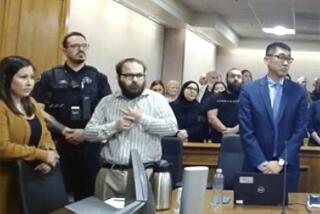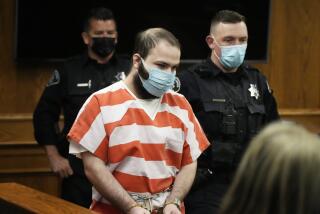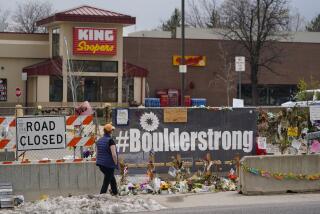James Holmes guilty of murder in Colorado theater massacre; jury to weigh death penalty
After three months of wrenching testimony — the victims’ tales of pain and loss, the careful planning of a meticulous killer — the jury weighing the fate of the Colorado theater gunman needed only 12 hours to decide that James E. Holmes was guilty of 165 counts of murder and attempted murder.
The verdicts came on the second day of deliberations.
Defense attorneys had argued that Holmes was insane when he carried out the rampage on July 20, 2012. Prosecutors had contended that it was possible for Holmes to be mentally ill but legally sane.
The 27-year-old former neuroscience graduate student, jurors decided, was sane when he stormed the suburban Denver movie theater in Aurora, killing 12 people and injuring 70 others.
The courtroom was silent as Arapahoe County Judge Carlos A. Samour Jr. read the verdicts and the names of the victims. Holmes stood motionless beside his attorneys. The only sound was the rustle of pages as the judge made his way through the charges.
“Verdict form Count 1, murder in the first degree after deliberation, Jonathan Blunk,” he began. “We the jury find the defendant James Eagen Holmes guilty of murder in the first degree after deliberation.”
Jurors left unanswered Part B of every count: “Did you find the defendant not guilty on this count solely based on the defense of insanity?” And they answered “yes” to Part C of each three-part count: “Did the defendant use, or possess and threaten the use of, a deadly weapon?”
The process took about an hour.
Legal experts following the trial were shocked by the jury’s speed.
“I am very surprised the jury is back with a verdict so soon, especially since the judge told the jury it had to work through each and every count,” said Rick Kornfeld, a former assistant U.S. attorney. “It’s hard to read the tea leaves regarding a short deliberation in a long trial, but it certainly means that the losing side was not in the game in the eyes of the jury in terms of the strength of their argument.”
The trial now enters the penalty phase. Samour told jurors that court would be in session again next Wednesday and admonished them not to talk about the case and to ignore all media reports in their five days off.
“You’ll have two options,” Samour told the jury after the verdicts were read, “life in prison without the possibility of parole or the death penalty. Those are the only choices.”
Several survivors spoke to the media after the verdict.
“We’ve been waiting for this day for a long time,” Marcus Weaver, who was injured, told CBS Denver. Weaver’s friend Rebecca Wingo was killed. “I think the jury got it right. ... I’ve always said vengeance is the Lord’s. The jury got it right on all counts.... I just broke down crying. I couldn’t hold it back any more. Nothing can prepare you for a day like this.”
Jansen Young, the girlfriend of victim Jonathan Blunk, told CNN that uncertainty was replaced with relief when Samour read the jury’s verdicts.
“Justice is here,” she said. “This is a huge step forward today.”
But Jordan Ghawi, whose sister Jessica Ghawi was killed in the rampage, tweeted before the verdicts a fear that was on many minds: “I have no doubt that the jury will return a guilty verdict on all ... counts. I am only concerned with the sentencing phase.”
Craig Silverman, a former Denver chief deputy district attorney who is now in private practice, predicted that it would be “impossible that the jury will return a verdict of life in prison given the monstrosity of this massacre.”
In Colorado, he told The Times, a unanimous verdict is necessary for the death penalty, which means that one juror voting for life in prison without the possibility of parole can basically decide the outcome.
The fast verdict Thursday bodes well, he said, for the prosecution during the next phase of the trial.
“The only danger now for the prosecution is a holdout juror,” Silverman said. “But given the speed of the underlying verdict, I don’t anticipate a holdout.”
Democratic Gov. John Hickenlooper said he hoped that the jury’s verdict would bring comfort.
“This has been an emotional and difficult time for the victims, their families, loved ones and friends,” Hickenlooper said in a statement. “My hope is that this step brings some peace to each of them, and begins the healing process for all of Colorado.”
That Holmes carefully planned the horrific attack, cased the suburban Denver movie theater, strapped on an assault rifle, a shotgun and a Glock pistol and blasted his way through a midnight screening of “The Dark Knight Rises” was never in doubt.
Holmes acknowledged that he had orchestrated and carried out the rampage, but he pleaded not guilty by reason of insanity.
“That guy was sane beyond a reasonable doubt, and he needs to be held accountable for what he did,” Arapahoe County Dist. Atty. George H. Brauchler told the jurors in his closing argument Tuesday.
When the audience of more than 400 people entered the theater, “they came in hoping to see the story of a hero dressed in black, someone who would fight insurmountable odds for justice,” Brauchler said. “Instead, a different figure appeared by the screen.... He came there with one thing in his heart and his mind, and that was mass murder.
“When he goes into that theater, he intends to kill everybody he can,” Brauchler told the jurors. “He creates a kill box.”
Defense attorney Daniel King argued Holmes had been mentally ill even before the 2012 attack and urged jurors to look beyond how the gunman planned his attack. The prosecution contended that the deliberate nature of the planning and execution of the attack showed that Holmes was not mentally ill.
“There isn’t a lot of logic in what Mr. Holmes did,” King said. “That’s because he is mentally ill. ... It’s not logical. It defies the logical process. It’s psychotic.”
The three-month trial — during which jurors heard from more than 250 witnesses and pored over thousands of pages of evidence — was deeply emotional. Brauchler interspersed the dry testimony of forensic and technical experts with wrenching stories from the blood-soaked theater.
He began his case with dramatic testimony from Katie and Caleb Medley. She was nine months pregnant when Holmes began firing. He was an aspiring stand-up comedian. She gave birth on one hospital floor while he underwent brain surgery on another. He testified from his wheelchair using an alphabet board to tap out his answers. He can no longer speak.
Brauchler finished his case with Ashley Moser, who became the face of loss for the massacre, which has scarred both its victims and the community. Moser had just had her first ultrasound; she and her 6-year-old daughter, Veronica Moser-Sullivan, went to the movie to celebrate the new baby.
Moser, paralyzed, testified from her wheelchair. Her little girl is dead. She lost the child she was carrying.
In between came the meat of the state’s case. The prosecution had the burden of proving that Holmes was sane at the time of the shooting and used Holmes’ private journal and 22 hours of recorded interviews with a court-appointed psychiatrist to that end.
In the journal, Holmes had plotted out how he chose the venue for his rampage, how he bought his gear, how he decided that killing as many people as possible in a crowded space was preferable to a bombing or biological weapons strike or a rampage in which he attacked one person at a time.
In the interviews, he told Dr. William Reid that he had stopped dating a classmate at the University of Colorado because he did not want her to be saddled with the chilling moniker: a murderer’s girlfriend.
That, the prosecution argued, was evidence that Holmes knew the difference between right and wrong. Holmes, Reid testified, was mentally ill, but legally sane.
“Is it your opinion that the defendant suffered from or met the diagnostic criteria for a mental illness?” Brauchler asked him midway through the trial.
“Yes,” he said.
“Despite what that mental illness is,” Brauchler asked, “is it your opinion the defendant had the capacity to know right from wrong as the court defined it for this jury?”
“Yes,” Reid said.
“Is it your opinion that the defendant met the definition of legal sanity?” Brauchler asked.
“Yes,” Reid said again.
The defense put nine psychiatrists or psychologists on the witness stand to persuade the jury that Holmes was “floridly psychotic” at the time of the attack and also used the same notebook wielded by the prosecution to its own ends.
Because not only was the slender volume filled with meticulous plans for a massacre, it also held pages of unintelligible rantings, strange calculations and the world view of what defense attorneys said was a schizophrenic who dreamed about killing people as a child.
Dr. Raquel Gur, the defense’s star witness, had questioned the gunman for 28 hours over six days, starting in late 2012.
“The severity and intensity of his psychosis,” she testified, “was so high, so severe, as to render him incapable of distinguishing between right and wrong.”
ALSO:
Mohammad Youssef Abdulazeez identified as gunman who killed 4 Marines
Obama becomes first president to visit prison, but reform push has limits
Man shot by LAPD outside Venice coffee shop dies
More to Read
Sign up for Essential California
The most important California stories and recommendations in your inbox every morning.
You may occasionally receive promotional content from the Los Angeles Times.











